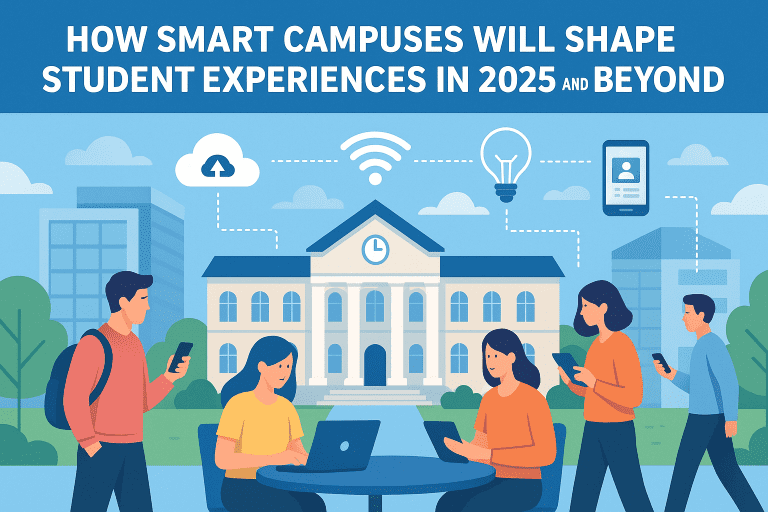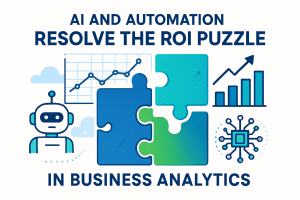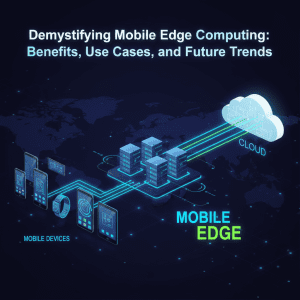Introduction
In 2025, the age of the smart campus is in full swing. Universities are embracing digital transformation far beyond online classes—integrating the Internet of Things (IoT), artificial intelligence (AI), and advanced data analytics to redefine every aspect of the student journey. From daily convenience to new ways of learning, smart campuses are setting new standards for engagement, support, and innovation in higher education.
What Is a Smart Campus?
A smart campus blends physical and digital environments, connecting infrastructure, people, and systems through technologies like IoT sensors, AI assistants, big data platforms, and cloud services. The result: environments that are not just connected, but adaptive, sustainable, and deeply personalized to each student’s needs.
Core Pillars: How Smart Campuses Transform Student Life
1. Personalized & Immersive Learning
-
IoT-enabled classrooms: Sensors track engagement and personalize learning materials in real time, while smartboards and AR/VR experiences turn lectures into interactive journeys.
-
AI tutors: Virtual assistants guide students, answer questions instantly, and support self-paced, adaptive learning far beyond the classroom.
-
Seamless hybrid experiences: Whether on-campus or remote, students enjoy the same resources, collaboration tools, and educator access.
2. Enhanced Campus Services & Daily Convenience
-
Smart apps: Students use unified mobile apps to book study rooms, access resources, navigate facilities, and even find open parking spaces—all powered by real-time data.
-
Automated amenities: Dorm climate adjusts automatically; face or voice recognition provides secure access; digital kiosks update schedules and announcements instantly.
-
Flow management: IoT integrates crowd movement analytics for less congestion and optimized use of shared spaces.
3. Well-Being, Safety, and Inclusivity
-
Smart housing and health: Digital health services, wellness trackers, and smart housing improve student well-being.
-
Safety systems: AI-powered video, smart lighting, and emergency apps provide instant alerts and rapid response, while digital platforms enable anonymous feedback and support.
-
Universal access: Speech recognition, accessible content, and remote tech ensure inclusivity for students with diverse needs.
4. Sustainability and Campus Efficiency
-
Green technology: Smart buildings monitor and minimize energy, water, and waste; real-time data enables universities to meet ambitious sustainability goals.
-
Resource optimization: Automated scheduling and predictive maintenance save universities money, allowing more funding for student initiatives.
-
Living labs: Students can work on real-world sustainability and technology projects enabled by smart campus infrastructure.
5. Community, Engagement, and Belonging
-
Data-driven engagement: Digital platforms connect students with clubs, events, and mental health resources, fostering a greater sense of belonging.
-
Collaborative environments: Cloud-based tools and connected spaces make teamwork, research, and networking seamless—across campus or worldwide.
Real-World Example
-
Arizona State University: Apps provide services from finding open parking to tracking event satisfaction, while IoT sensors help optimize facilities for energy use and student comfort.
-
UC San Diego: IoT smart meters have cut energy use by 20%, making the campus greener and budgets more student-focused.
Key Trends to Watch in 2025 and Beyond
| Trend | Impact on Students |
|---|---|
| AI & Analytics Everywhere | Hyper-personalized experiences and support |
| AR/VR-Driven Classrooms | Immersive, experiential learning on demand |
| Touchless & Frictionless | Convenience, seamless access, and heightened security |
| Data-Driven Well-Being | Proactive health, safety, and engagement interventions |
| Campus-as-a-Service Models | Flexible, subscription-like access to services/amenities |
Frequently Asked Questions
How does a smart campus benefit students daily?
Better safety, faster access to resources, personalized learning, lower costs, and more confidence in navigating campus life.
Will smart campuses make learning more inclusive?
Yes! Universal design features and tech for accessibility ensure every student can thrive, regardless of ability.
What about privacy and data?
Institutions are prioritizing privacy, transparency, and security as foundational to every smart campus initiative.
Conclusion
Smart campuses represent a bold leap toward student-centered, future-ready education. By combining intelligent infrastructure with data-driven insight and seamless digital integration, these campuses help students learn, live, and succeed like never before. The impacts: stronger engagement, greater well-being, more sustainable communities—and lifelong value for every graduate.











